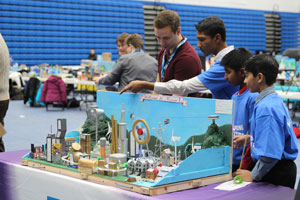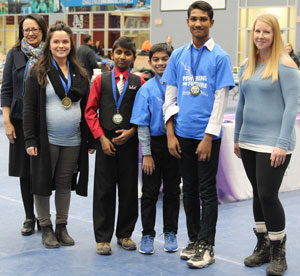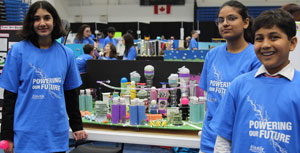
Students from Lord Elgin Public School win the 2019 Future City regional competition

On January 22, Durham District School Board (DDSB) students and educators gathered at the University of Ontario Institute of Technology (UOIT) Health and Wellness Centre in Oshawa to compete in the regional Future City competition. This year’s theme was Powering Our Future.
Future City is a regional and international competition in which students from Grades 6 to 8 ask the question “how can we make the world a better place?”, and answer by imagining, designing, and building a futuristic city. They were challenged to design a resilient power grid that can withstand, and quickly recover from, the impacts of a natural disaster.
Over 80 DDSB teams displayed and presented their futuristic cities while a panel of judges analyzed and inquired about their projects. After each team’s project had been assessed individually, the judges consulted and chose the top five teams to present their models to all the participants.
Modest winners

Ponnezhil, Mahir, and Junaid from Lord Elgin Public School won first place with their coastal Japanese city, Nagoya. This means they will travel to Washington, D.C. in February to take on the international Future City competition. “There were a lot of good teams here. It was very unexpected and we are proud to have accomplished our goal,” says Ponnezhil.
Based on their design, Nagoya’s power grid was built to withstand flooding, and would do so using a variety of engineering tactics. Nagoya has intelligent floodwater pumps across the city to pump out excess water. Also, each zone within the city has a distribution centre powered by individual substations which are elevated to avoid water damage.
The students spent roughly four months preparing a project plan (to help them stay on schedule), a city essay (that describes the unique attributes of their city and provides a solution to the theme), a city model, and a city presentation (to be presented to engineering professionals who judge the competition).
Maddy Tyrrell, Teacher at Lord Elgin PS, says she was thrilled to see her three students so engaged in the project. She is now looking forward to the international competition, “It was definitely a unique experience to watch a young group of students come up with such innovative and inspiring ideas for the future. We are so looking forward to sharing these ideas in Washington.”
Jane Kennedy, Science Technology Engineering and Math (STEM) Facilitator at the DDSB, explains why the competition is key to students’ learning, “Instead of learning math, science, or geography separately, Future City integrates all kinds of subjects into one project-based competition.” She adds, “Post-secondary learning and the workforce are fully integrated, so it’s important for students to experience that now, to prepare them for their futures.”

Leave a Reply